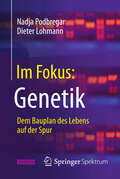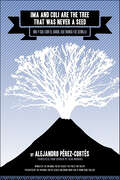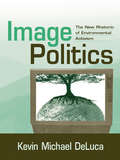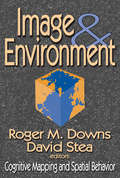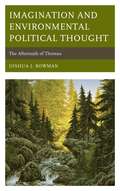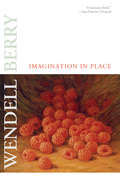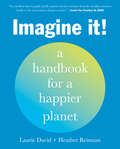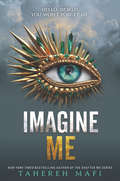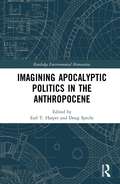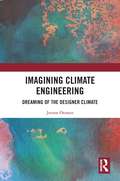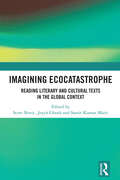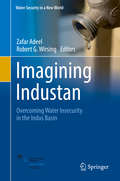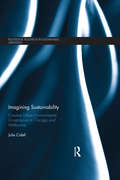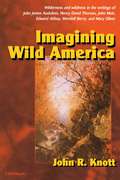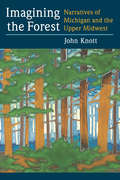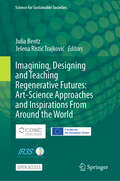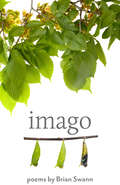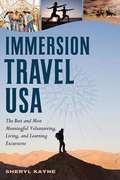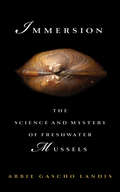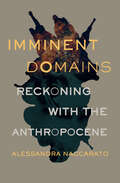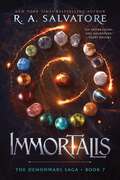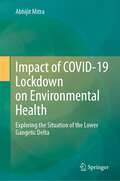- Table View
- List View
Im Fokus: Dem Bauplan des Lebens auf der Spur
by Nadja Podbregar Dieter LohmannWelche Macht haben unsere Gene? Sind sie die schicksalhafte Blaupause, die bestimmt, wie intelligent, wie alt oder wie schön wir sind? Lange Zeit war dies die gängige Lehrmeinung. Doch das Dogma ihrer monolithischen Allmacht ist heute längst gefallen. Immer häufiger stoßen Forscher auf Hinweise, wie unser Leben den Genen "ins Handwerk" pfuscht und wie eng die Wechselwirkungen zwischen Erbgut, Stoffwechsel und Umwelt manchmal sind. Die moderne Biotechnologie eröffnet neue Wege der Forschung, wirft aber auch ethische und gesellschaftliche Fragen auf. Dieses Buch erklärt unter anderem, warum bei den Genen die Verpackung manchmal wichtiger ist als der Inhalt, was Viren in unserem Erbgut verloren haben und weshalb es "das Methusalem-Gen" nicht gibt.
Ima and Coli Are the Tree That Was Never a Seed
by Alejandro Pérez-CortésThe new winner of the Paz Prize for Poetry, granted by the National Poetry Series, is the author’s impressionistic homage to his hometown of Colima, Mexico.“In this remarkable bilingual debut . . . Pérez-Cortés cracks open the name of his hometown, Colima, to generate a vast mythology . . . The side-by-side presentation of the original Spanish and its English translation adds another layer to this engrossing volume.” —BooklistA Poets & Writers Page One SelectionIma and Coli Are the Tree That Was Never a Seed is Alejandro Pérez-Cortés’s personal genesis of Colima, Mexico, published here in both English and Spanish. The tree is an element/character in the book that appears and disappears throughout. Some poems are set in an ancient pre-Hispanic Colima; others reflect the reality of a modern-day Colima, sadly stigmatized and eroded by violence perpetrated by the narcos.In his introduction, preeminent Cuban poet José Kozer praises Pérez-Cortés: “Ima and Coli Are the Tree That Was Never a Seed comprises a voice that I consider poetic and that should be cared for and listened to with true interest. A voice that encompasses all, one that seeks to integrate, remake, and modify normative language when necessary, and to distort language that allows a better perception of the present and of everything that is historically behind a contemporary poet.”The Paz Prize for Poetry is presented by the National Poetry Series and Miami Book Fair at Miami Dade College and is awarded biennially. Named in the spirit of the late Nobel Prize–winning poet Octavio Paz, it honors a previously unpublished book of poetry written originally in Spanish by an American resident.
Image Politics: The New Rhetoric of Environmental Activism (Revisioning Rhetoric Ser.)
by Kevin Michael DeLucaThis exceptional volume examines “image events” as a rhetorical tactic utilized by environmental activists. Author Kevin Michael DeLuca analyzes widely televised environmentalist actions in depth to illustrate how the image event fulfills fundamental rhetorical functions in constructing and transforming identities, discourses, communities, cultures, and world views. Image Politics also exhibits how such events create opportunities for a politics that does not rely on centralized leadership or universal metanarratives. The book presents a rhetoric of the visual for our mediated age as it illuminates new political possibilities currently enacted by radical environmental groups. Chapters in the volume cover key areas of environmental activism such as:*The rhetoric of social movements;*Imaging social movements;*Environmental justice groups; and*Participatory democracy. This book is of interest to scholars and students of rhetorical theory, media and communication theory, visual theory, environmental studies, social change movements, and political theory. It will also appeal to others interested in ecology, radical environmental politics, and activism, and is an excellent supplemental text in advanced undergraduate and graduate level courses in these areas.
Image and Environment: Cognitive Mapping and Spatial Behavior
by Roger M. Downs David SteaCognitive mapping is a construct that encompasses those processes that enable people to acquire, code, store, recall, and manipulate information about the nature of their spatial environment. It refers to the attributes and relative locations of people and objects in the environment, and is an essential component in the adaptive process of spatial decision-making--such as finding a safe and quick route to from work, locating potential sites for a new house or business, and deciding where to travel on a vacation trip.Cognitive processes are not constant, but undergo change with age or development and use or learning. Image and Environment, now in paperback, is a pioneer study. It brings a new academic discipline to a wide audience. The volume is divided into six sections, which represent a comprehensive breakdown of cognitive mapping studies: "Theory"; "Cognitive Representations"; "Spatial Preferences"; "The Development of Spatial Cognition"; "Geographical and Spatial Orientation"; and "Cognitive Distance." Contributors include Edward Tolman, James Blaut, Stephen Kaplan, Terence Lee, Donald Appleyard, Peter Orleans, Thomas Saarinen, Kevin Cox, Georgia Zannaras, Peter Gould, Roger Hart, Gary Moore, Donald Griffin, Kevin Lynch, Ulf Lundberg, Ronald Lowrey, and Ronald Briggs.
Images Of Micronesia: Images And Writings Of Micronesia
by Evelyn Flores Brian L. MillhoffCollection if images both written and visuals of Micronesia. The short stories and poetry are written by both student and semi-proffesional writers native to the Micronesia islands.
Images of Anarchy
by Ioannis D. EvrigenisHobbes's concept of the natural condition of mankind became an inescapable point of reference for subsequent political thought, shaping the theories of emulators and critics alike, and has had a profound impact on our understanding of human nature, anarchy, and international relations. Yet, despite Hobbes's insistence on precision, the state of nature is an elusive concept. Has it ever existed and, if so, for whom? Hobbes offered several answers to these questions, which taken together reveal a consistent strategy aimed at providing his readers with a possible, probable, and memorable account of the consequences of disobedience. This book examines the development of this powerful image throughout Hobbes's works, and traces its origins in his sources of inspiration. The resulting trajectory of the state of nature illuminates the ways in which Hobbes employed a rhetoric of science and a science of rhetoric in his relentless pursuit of peace.
Imagination and Environmental Political Thought: The Aftermath of Thoreau (Politics, Literature, and Film)
by Joshua J. Bowman<p>Imagination and Environmental Political Thought: The Aftermath of Thoreau seeks to correct oversimplified readings of Henry David Thoreau’s political thought by elucidating a key tension within his imagination. With the celebration of Thoreau’s two-hundredth birthday now past, this study outlines, and builds on, his own understanding of imagination and considers its implications for environmental politics. Despite the use of the word, “aftermath,” Thoreau’s legacy for environmental political thought is primarily constructive and foundational for modern environmentalism. <p>Thoreau’s virtues and vices have been inherited by his environmentally-conscious readers. The author of Walden’s preference for an abstract, ahistorical “higher law,” his radical concept of autonomy, and his frustration with government and community foster an impractical political thought characteristic of an idyllic imagination. Nevertheless, Thoreau demonstrates a more prudential and moral imagination by emphasizing the inescapable relationship between the moral order of individuals and the order of political communities and by pioneering the central questions of humanity’s relationship to non-human nature. Can this tension of imaginations be resolved? What are the consequences of this tension? <p>Thoreau’s overall vision ultimately creates significant problems with which environmentalists still struggle. While Thoreau’s emphasis on freedom and the immaterial aspects of human and non-human nature are of considerable value, his abstract political morality, misanthropy and escapism must be resisted both for the sake of environmental well-being and human dignity. <p>In addition, this book is an exercise in re-thinking how the humanities may provide scholars critical insights to better diagnose and respond to the environmental challenges of our time.</p>
Imagination in Place
by Wendell Berry“Berry's latest collection of essays is the reminiscence of a literary life. It is a book that acknowledges a lifetime of intellectual influences, and in doing so, positions Berry more squarely as a cornerstone of American literature . . . A necessary book. Here, Berry's place as the 'grandfather of slow food' or the 'prophet of rural living' is not questioned. This book ensures we understand the depth and breadth of Berry's art.” —San Francisco Chronicle “[A] stellar collection . . . Foodies, architects, transportation engineers, and other writers are adopting and adapting [Berry’s] concepts, perhaps leading to what he envisions will one day be 'an authentic settlement of our country.'“ —The OregonianA writer who can imagine the “community belonging to its place” is one who has applied his knowledge and citizenship to achieve the goal to which Wendell Berry has always aspired—to be a native to his own local culture. And for Berry, what is “local, fully imagined, becomes universal,” and the “local” is to know one's place and allow the imagination to inspire and instill “a practical respect for what is there besides ourselves."In Imagination in Place, we travel to the local cultures of several writers important to Berry's life and work, from Wallace Stegner's great West and Ernest Gaines' Louisiana plantation life to Donald Hall's New England, and on to the Western frontier as seen through the Far East lens of Gary Snyder. Berry laments today's dispossessed and displaced, those writers and people with no home and no citizenship, but he argues that there is hope for the establishment of new local cultures in both the practical and literary sense.Rich with Berry's personal experience of life as a Kentucky agrarian, the collection includes portraits of a few of America's most imaginative writers, including James Still, Hayden Carruth, Jane Kenyon, John Haines, and several others.
Imagine It!: A Handbook for a Happier Planet
by Laurie David Heather ReismanAn inspirational, accessible, and actionable guide for empowering and inspiring you to take concrete steps towards living more sustainably. &“An excellent how-to guide [and] a great read for everyone from the socially conscious family to the most ardent climate activist.&”—Former Vice President Al GoreImagine It! is a handbook for those who want to begin or advance a journey toward living in better balance with our planet. It inspires, supports, and offers easy ways to replace old, planet-hurting habits with new healthy ones. In Imagine It!, the documentary filmmakers behind Writing on the Wall, Fed Up, The Biggest Little Farm, The Social Dilemma, and the Academy Award–winning An Inconvenient Truth highlight the need to change some of our food, clothing, and transportation habits and meaningfully lower our use of plastic, paper, water, and harmful chemicals. They call the changes in these areas lifestyle shifts, and there is a chapter devoted to each one of them in the book. Each begins with a short story on the shift being explored, and then provides clear steps for replacing old habits with new ones to create lasting change. Laurie David and Heather Reisman are no strangers to exposing hard truths and helping audiences understand their part in bringing about change. They know a cleaner, healthier world is ours for the taking—and to start, we just have to Imagine It!
Imagine Me (Shatter Me #6)
by Tahereh MafiThe explosive finale to the New York Times and USA Today bestselling Shatter Me series.Juliette Ferrars. Ella Sommers. Which is the truth and which is the lie? Now that Ella knows who Juliette is and what she was created for, things have only become more complicated. As she struggles to understand the past that haunts her and looks to a future more uncertain than ever, the lines between right and wrong—between Ella and Juliette—blur. And with old enemies looming, her destiny may not be her own to control.The day of reckoning for the Reestablishment is coming. But she may not get to choose what side she fights on.
Imagining Apocalyptic Politics in the Anthropocene (Routledge Environmental Humanities)
by Earl T. HarperBringing together scholars from English literature, geography, politics, the arts, environmental humanities and sociology, Imagining Apocalyptic Politics in the Anthropocene contributes to the emerging debate between bodies of thought first incepted by scholars such as Mouffe, Whyte, Kaplan, Hunt, Swyngedouw and Malm about how apocalyptic events, narratives and imaginaries interact with societal and individual agency historically and in the current political moment. Exploring their own empirical and philosophical contexts, the authors examine the forms of political acting found in apocalyptic imaginaries and reflect on what this means for contemporary society. By framing their arguments around either pre-apocalyptic, peri-apocalyptic or post-apocalyptic narratives and events, a timeline emerges throughout the volume which shows the different opportunities for political agency the anthropocenic subject can enact at the various stages of apocalyptic moments. Featuring a number of creative interventions exclusively produced for the work from artists and fiction writers who engage with the themes of apocalypse, decline, catastrophe and disaster, this innovative book will be of great interest to students and scholars of the politics of climate change, the environmental humanities, literary criticism and eco-criticism.
Imagining Climate Engineering: Dreaming of the Designer Climate
by Jeroen OomenThis book highlights the increasing attention for climate engineering, a set of speculative technologies aimed to counter global warming. What is the future of the global climate? And who gets to decide—or even design—this future? Imagining Climate Engineering explores how and why climate engineering became a potential approach to anthropogenic climate change. Specifically, it showcases how views on the future of climate change and climate engineering evolved by addressing the ways in which climate engineers view its respective physical, political, and moral domains. Tracing the intellectual and political history of dreams to control the weather and climate as well as the discovery of climate change, Jeroen Oomen examines the imaginative parameters within which contemporary climate engineering research takes place. Introducing the analytical metaphor ‘ways of seeing’ to describe explicit or implicit visions, understandings, and foci that facilitate a particular understanding of what is at stake, Imagining Climate Engineering shows how visions on the knowability of climate tie into moral and political convictions about the possibility and desirability of engineering the climate. Marrying science and technology studies and the environmental humanities, Oomen provides crucial insights for the future of the climate change debate for scholars and students.
Imagining Ecocatastrophe: Reading Literary and Cultural Texts in the Global Context
by Scott Slovic Joyjit Ghosh Samit Kumar MaitiThis volume examines scholarly perspectives on eco-imaginaries, focusing in particular on how eco-catastrophes have been represented in literature and different visual forms, including film, television and cartoons, among other cultural media. It draws on literary genres such as science fiction, climate fiction, speculative fiction, petrofiction, post-apocalyptic narratives and nuclear fiction to examine the role that literature plays in the dissemination of information about environmental crisis in the Anthropocene and in preparing mankind for a better and sustainable future. Deeply embedded in theoretical conceptualisations, the essays in this volume address issues of natural disasters, deforestation, nuclear disasters and pandemics, among others, which constitute the core subjects of environmental humanities. A seminal study on the literary and cultural representations of ecodisaster in the global context, and with contributions from across the world, this book, truly interdisciplinary in nature, will be an invaluable read for students, academicians and researchers in literature, film studies, climate change studies, disaster studies, gender studies and cultural studies.
Imagining Industan
by Zafar Adeel Robert G. WirsingThis volume calls upon over a dozen Indus observers to imagine a scenario for the Indus basin in which transboundary cooperation over water resources overcomes the insecurity arising from water dependence and scarcity. From diverse perspectives, its essays examine the potential benefits to be gained from revisiting the 1960 Indus Waters Treaty, as well as from mounting joint efforts to increase water supply, to combat climate change, to develop hydroelectric power, and to improve water management. The Indus basin is shared by four countries (Afghanistan, China, India, and Pakistan). The basin's significance stems in part simply from the importance of these countries, three of them among the planet's most populous states, one of them boasting the world's second largest economy, and three of them members of the exclusive nuclear weapons club. However, the basin's significance stems also from the great importance of the Indus waters themselves - due especially to the region's massive dependence on irrigated agriculture as well as to the menace of climate change and advancing water scarcity. The "Industan" this volume imagines is a definite departure from business as usual responses to the Indus basin's emerging fresh water crisis. The objective is to kindle serious discussion of the cooperation needed to confront what many water experts believe is developing into one of the planet's most gravely threatened river basins. It is thus both assessment of the current state of play in regard to water security in the Indus basin and recommendation about where to go from here.
Imagining Sustainability: Creative urban environmental governance in Chicago and Melbourne (Routledge Research in Sustainable Urbanism)
by Julie CidellCities, rather than nations, have become the key sites for enacting environmental policies. This is due to the combination of growing urban populations and increased action on the part of local governments (generally attributed to national governments’ failure to act on climate change). Imagining Sustainability seeks to understand how actors in local government conceptualize sustainability and their role in producing it, and what difference that understanding makes to their physical, political, and social environments now and in the future. International comparisons can uncover new ideas and possibilities. Chicago and Melbourne are prime candidates for such a comparison: they are cities of the same age, they have similar historical trajectories as interior gateways followed by industrial growth and then deindustrialization, and they have demonstrated the same recent desire to be global champions of sustainability. Based on qualitative fieldwork in these two cities, this book uses Karen Barad’s methodology of diffraction to read these case studies through each other. This methodology helps to understand not only what differences exist between these two places, but what effects those differences have on the urban environment. This book will be of great interest to students and scholars of urban studies, urban planning and environmental policy and governance.
Imagining Wild America
by John R. KnottAt a time when the idea of wilderness is being challenged by both politicians and intellectuals,Imagining Wild Americaexamines writing about wilderness and wildness and makes a case for its continuing value. The book focuses on works by John James Audubon, Henry David Thoreau, John Muir, Edward Abbey, Wendell Berry, and Mary Oliver, as each writer illustrates different stages and dimensions of the American fascination with wild nature. John Knott traces the emergence of a visionary tradition that embraces values consciously understood to be ahistorical, showing that these writers, while recognizing the claims of history and the interdependence of nature and culture, also understand and attempt to represent wild nature as something different, other. A contribution to the growing literature of eco-criticism, the book is a response to and critique of recent arguments about the constructed nature of wilderness. Imagining Wild Americademonstrates the richness and continuing importance of the idea of wilderness, and its attraction for American writers. John R. Knott is Professor of English, University of Michigan. His previous books includeThe Huron River: Voices from the Watershed,coedited with Keith Taylor.
Imagining the Forest // Narratives of Michigan and the Upper Midwest
by John Knott"Forests have always been more than just their trees. The forests in Michigan (and similar forests in other Great Lakes states such as Wisconsin and Minnesota) played a role in the American cultural imagination from the beginnings of European settlement in the early 19th century to the present. Our relationships with those forests have been shaped by the cultural attitudes of the times, and people have invested in them both moral and spiritual meanings. Author John Knott draws upon such works as Simon Schama's Landscape and Memory and Robert Pogue Harrison's Forests: The Shadow of Civilization in exploring ways in which our relationships with forests have been shaped, using Michigan-its history of settlement, popular literature, and forest management controversies-as an exemplary case. Knott looks at such well-known figures as William Bradford, James Fenimore Cooper, John Muir, John Burroughs, and Teddy Roosevelt; Ojibwa conceptions of the forest and natural world (including how Longfellow mythologized them); early explorer accounts; and contemporary literature set in the Upper Peninsula, including Jim Harrison's True North and Philip Caputo's Indian Country. Two competing metaphors evolved over time, Knott shows: the forest as howling wilderness, impeding the progress of civilization and in need of subjugation, and the forest as temple or cathedral, worthy of reverence and protection. Imagining the Forest shows the origin and development of both"--
Imagining, Designing and Teaching Regenerative Futures: Art-Science Approaches and Inspirations From Around the World (Science for Sustainable Societies)
by Julia Bentz Jelena Ristić TrajkovićThis open access book explores the potential of transdisciplinary, art-science approaches in addressing current social-ecological complexities within educational contexts. Moving beyond disciplinary perspectives this book integrates holistic, transdisciplinary approaches and creates spaces for imagining and co-creating just, liveable, healthy futures. As we face the urgent need for new ways of learning and engaging with nature, this volume emphasizes the importance of humans as integral parts of living systems. By fostering a regenerative and holistic perspective while improving wellbeing for humans and non-humans, the book offers tools and methods that invite learners to reimagine their relationships with nature and with the future. It includes innovative approaches for community engagement, design, future visioning, experiential, embodied, and playful learning, providing a comprehensive resource for educators, community workers, policy makers, designers, scientists, architects, and urban planners. The book brings together creative, art-science approaches to advance transformative education in the field of sustainability science. Structured as a practical manual, it offers innovative methodologies with clear instructions for application in various learning environments. Offering tutorials for 65 creative methods developed by the 120 authors from all around the world, this book offers a transdisciplinary and transcontextual approach making it relevant to a wide audience. This collaborative project is an output of the Cost Action CA21166 - Social Sciences and Humanities for Transformation and Climate Resilience (SHiFT) that brings together researchers and practitioners from different disciplines to address sustainability transformation.
Imago (Johns Hopkins: Poetry and Fiction)
by Brian SwannAn exuberant collection of poems celebrating art, nature, and humanity.This various and vital poetry collection, in rich language and sharp detail, spans the rural and urban, country and town, and foreign and domestic. Tracing the vagaries of the self, these poems record and transmute biography from an English youth to the trials and challenges of aging in America. Memorable for its exuberant voice and exacting eye, Brian Swann's Imago is awake to the natural world as well as the world within. From the half-page title poem to the multi-section "Elegiac," this volume is striking in its largeness, its tone evolving from self-indicting to ecstatic and self-transcendent. This collection, the author's fourteenth, is moving both as art and as testament.Imago unfolds much like a piece of music. It is a continuum by which Swann sees nature and art interwoven in the ways they emerge and change. In "Grief and Magritte," Swann muses upon "all of us snagged in a net whose skeins tangle in night sky / where one star dreams another." The title poem focuses on an insect "on its way through the changes, the patterns / of what led up to it, the catches and releases . . . saying now, and now" till "splitting down the back" such changes "release what was always there." Brian Swann's poems, moving in their candor, read as though they have always been there, too.
Imayamalai
by S. MohanaThe book gives the mythological, historical and geographical details of the Himalayas, the great mountain of India.
Immersion Travel U.S.A.: The Best and Most Meaningful Volunteering, Living, and Learning Excursions
by Sheryl KayneImmersion travel is for everyone at all ages and stages of life. It means taking an active part in where you visit in order to learn about the culture, traditions, and characteristics of each particular place. Designed to be a resource and idea book, this guide provides practical information about immersion travel, special considerations and costs, and how to plan and take vacations, sabbaticals, side trips, and more.
Immersion: The Science and Mystery of Freshwater Mussels
by Abbie Gascho LandisAbbie Gascho Landis first fell for freshwater mussels while submerged in an Alabama creek, her pregnant belly squeezed into a wetsuit. After an hour of fruitless scanning, a mussel materialized from the rocks—a little spectaclecase, herself pregnant, filtering the river water through a delicate body while her gills bulged with offspring. In that moment of connection, Landis became a mussel groupie, obsessed with learning more about the creatures' hidden lives. She isn't the only fanatic; the shy mollusks, so vital to the health of rivers around the world, have a way of inspiring unusual devotion.In Immersion: The Science and Mystery of Freshwater Mussels, Landis brings readers to a hotbed of mussel diversity, the American Southeast, to seek mussels where they eat, procreate, and, too often, perish. Accompanied often by her husband, a mussel scientist, and her young children, she learned to see mussels on the creekbed, to tell a spectaclecase from a pigtoe, and to worry what vanishing mussels—70 percent of North American species are imperiled—will mean for humans and wildlife alike. In Immersion, Landis shares this journey, traveling from perilous river surveys to dry streambeds and into laboratories where endangered mussels are raised one precious life at a time.Mussels have much to teach us about the health of our watersheds if we step into the creek and take a closer look at their lives. In the tradition of writers like Terry Tempest Williams and Sy Montgomery, Landis gracefully chronicles these untold stories with a veterinarian's careful eye and the curiosity of a naturalist. In turns joyful and sobering, Immersion is an invitation to see rivers from a mussel's perspective, a celebration of the wild lives visible to those who learn to search.
Imminent Domains: Reckoning with the Anthropocene
by Alessandra NaccaratoImminent Domains: Reckoning with the Anthropocene invites readers to join a contemplation of survival—our own, and that of the elements that surround us. Using research, lyric prose, and first-hand experiences, Alessandra Naccarato addresses fundamental questions about our modern relationship to nature amidst depictions of landscapes undergoing dramatic transformation.We trace the veins of harm, memory and meaning amongst ecosystems and bioregions; through history and across continents, from the mines of Cerro Rico to the ruins of Pompeii. Arranged by five central elements of survival—earth, fire, water, air and spirit—these essays refute linearity, just as nature does.Naccarato offers not blanket answers about our future, but rather myriad ways to find our own, individual response to an imminent question. We are being called to work together; to dig a trench deep and wide enough that the fires around us might stay at bay. How do we turn towards the fire?
Immortalis: The DemonWars Saga, Book 7 (DemonWars series #7)
by R. A. SalvatoreIn this extraordinary third and final work in the second DemonWars trilogy, R. A. Salvatore weaves a diverse tapestry of characters and events from all novels of the series into an epic, unforgettable conclusion as a dark young king is driven by a quest to remake humankind.In Honce-the-Bear, King Aydrian Boudabras wakes in a cold sweat, his conscience haunted by those he has killed in order to garner power, including the rightful king before him, Danube, his mother&’s husband. Now, Aydrian is preparing his armies for war, forging loyalties, playing one adversary against another, and giving those around him barely a glimpse at his remarkable powers. In the neighboring Behren, the evil Yatol Bardoh is unleashing a war engine of his own, using armies of mercenaries and horrific tactics to bring down the walls of Jacintha and to drive a ferocious dragon from the city of Dharyan. Between these two men, an explosive chain of events has been set into motion. Refugees flood the roads and valleys, alliances are formed and broken, navies clash at sea, and assassins seek their moment to strike. With Aydrian&’s power and popularity turning into an avalanche and the courageous Byrnn Dharielle valiantly standing in the way of the Yalot Bardoh, the great players in the DemonWars saga will unite and clash on a single, magnificent stage. In book three of the second DemonWars trilogy, #1 New York Times bestselling author R. A. Salvatore concludes the second trilogy and gathers the whole arc of the seven books of the DemonWars saga in a stunning conclusion that Kirkus Reviews claims &“fans will dance with joy&” to experience.
Impact of COVID-19 Lockdown on Environmental Health: Exploring the Situation of the Lower Gangetic Delta
by Abhijit MitraThis book examines the impacts that the COVID-19 lockdown has had on environmental and ecological health, with a focus on coastal ecosystems in the Lower Gangetic Delta. The book begins with an overview of COVID-19's spread and impact before and after the lockdown in the focus region, then addresses the specific impacts that the lockdown period had and continues to have on air quality, marine and estuarine water quality, coastal biodiversity, and the livelihoods of the region's inhabitants, especially those who live below the poverty line. The decrease in human activity combined with the complete closure of various sectors, including air travel, oil and gas drilling, and construction, has had a pronounced effect on biodiversity and overall environmental health that is yet to be fully realized. The book sheds light on these changes and assesses how biodiversity, ambient air quality, and ecosystem functioning will progress as COVID-19 remains a threat and the lockdown persists. The study will be of interest to researchers, government officials and professionals dealing with disaster management, environmental science, biological science, and health.
